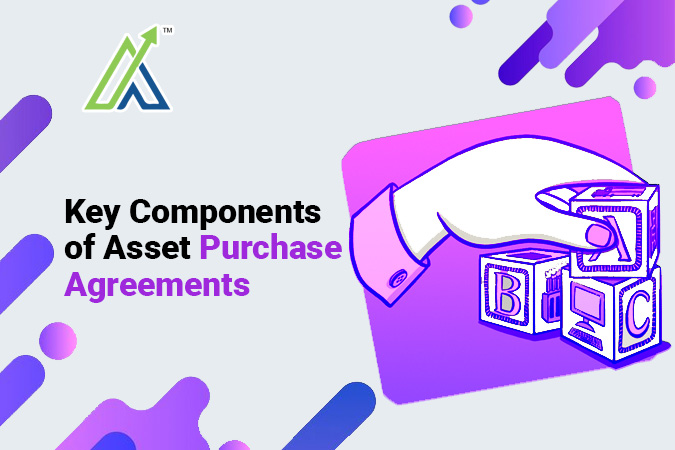What do you understand by Asset Purchase Agreements?
Asset Purchase Agreements (APAs) are important in business transactions because they contain the necessary terms of the transaction that enable the transfer of assets from one party to another. These are made prudently with the responsibility of the buyer and the seller, and they make sure that there is compliance with the legalities of the contract agreements.Components of Asset Purchase Agreements
Here is the detailed information of Components of Asset Purchase Agreements: –- Identifying Parties and Effective Date Identification of buyer and seller of an asset must be contained in it with their real names and permanent addresses. Also mentioning the date i.e. Effective date when the agreement becomes legal parties are being included.
- Assets Being Transferred Information regarding type of assets i.e. tangible and intangible assets must be include in it. Also, it is advisable to form a list of assets that are sold in detail and mentioning exclusions are very essentials to avoid confusions.
- Purchase Price and Terms of Payments It is important to provide details regarding total purchase price and the mode of payment that is used and also mention that if it paid in lump sum or in installments. Adjustments with respect to factors like working capital need to be mentioned in detail. It is mandatory to define terms of arrangement if the part of the payment is made in escrow (bond, guarantee, security etc.).
- Assumption of Liabilities Specify which liabilities and obligations the buyer will assume. This includes existing contracts and leases, helping both parties understand the responsibilities being transferred.
- Representations and Warranties Warranties are promises from the seller about the asset’s condition. They protect the buyer from any hidden problems that might not be obvious at first glance. Representations are made by the seller based on their actual asset disclosures. Buyers are shown what they’re getting into before the sale is finalised.
- Closing Conditions and Deliverables Before the transaction the conditions laid down must be satisfied. Having important approvals and due diligence is mandatory. Also, the list that have the details of documents and items need to be exchanged at closing
- Post-Closing Covenants These clauses cover actions required after the sale, like transition services, non-compete agreements, and handling of employee transfers. These ensure smooth post-closing operations and protect the buyer from competition by the seller.
- Dispute Resolution and Governing Law Include mechanisms for resolving disputes, such as mediation or arbitration, and specify the jurisdiction whose laws will govern the agreement.
- Confidentiality and Non-Disclosure The clauses that are used to protect vital information that is shared at the time of negotiation and execution. Non-Disclosure Agreements can be included for disclosure prevention by third parties.
- Termination and Remedies State the circumstances in which this agreement may be dissolved and the sanctions for noncompliance that may include monetary penalties and specific actions.
Questions to Understand your ability
Q: What must be crystal clear in the “Identification of Parties and Effective Date” section of an APA?- The real names and addresses of buyer and seller
- A breakdown of the assets up for grabs
- The exact amount of the purchase price
- The specific liabilities taken on by the buyer
- Payment terms spelled out
- A detailed list of sold assets and what’s not included
- The start date of the agreement
- Legal jurisdiction of the deal
- The deal’s kickoff date
- Liabilities the buyer’s picking up
- Total price tag and how the money flows
- How disputes get sorted out
- Docs to swap at closing time
- Conditions for calling off the deal
- Seller’s promises about the asset’s condition
- Ways to handle disagreements
- Closing Conditions and Docs
- Post-Closing Promises
- Liabilities Taken On
- Keeping Info Under Wraps
FAQ's
An Asset Purchase Agreement (APA) is a contract where one party sells its assets to another. It’s different from buying a company’s stock; you’re only buying the assets listed in the agreement.
Identifying the buyer and seller clearly, along with their addresses and the agreement’s effective date, ensures everyone knows who is involved and when the deal officially starts.
APAs can cover tangible assets like machinery and inventory, and intangible assets like patents and trademarks. It’s crucial to list these out in detail and mention any exclusions to avoid confusion later.
The total purchase price is agreed upon by both parties. Payment can be a lump sum or installments. Details about adjustments, like working capital changes, and if any part of the payment is held in escrow, should be included.
This specifies which debts and obligations the buyer will take on. It could include existing contracts, leases, or other commitments, clarifying what responsibilities are transferred along with the assets.
Representations are factual statements about the asset’s condition, while warranties are promises ensuring those facts. They protect the buyer from unexpected issues with the assets after the sale.
These are the requirements that must be met before finalizing the transaction. This includes necessary approvals, due diligence, and a list of documents to be exchanged at closing.
Post-closing covenants cover actions needed after the sale, like transition services or non-compete agreements. They ensure a smooth transition and protect the buyer from the seller starting a new competing business right away.

